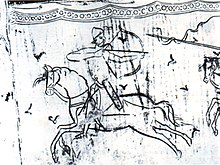
Back Bitva u Brenty Czech Batalo apud Brenta Esperanto Brenta menti csata Hungarian Pertempuran Brenta ID Battaglia del Brenta Italian ბრენტის ბრძოლა Georgian
| Battle of the Brenta river | |||||||
|---|---|---|---|---|---|---|---|
| Part of the Hungarian invasions of Europe | |||||||
 Hungarian warrior (10th century) from Patriarchate of Aquileia (fresco) | |||||||
| |||||||
| Belligerents | |||||||
| Kingdom of Italy |
| ||||||
| Commanders and leaders | |||||||
| Berengar I | Unknown Hungarian Commander | ||||||
| Strength | |||||||
| 15,000 | 5,000 | ||||||
| Casualties and losses | |||||||
| Almost all the Italian army | Minor | ||||||
The Battle of Brenta was fought between the cavalry of the Kingdom of Italy under King Berengar I, and the Hungarians hired by the East Francian king Arnulf of Carinthia, at an unidentified location in northern Italian Peninsula along the river Brenta on 24 September 899. It was one of the earliest battles of the Hungarian invasions of Europe. The result was a crushing defeat for Berengar I, allowing the Magyars (Hungarians) to continue west and sack large areas of Italy. The Hungarian invaders burned many cities, including Feltre, Vercelli, Modena, and monasteries like the monastery in Nonantola.
Arnulf of Carinthia died in December 899. As a result, the Hungarians, whom he had hired against the Italian king, left the kingdom the following year with all their plunder, but not before concluding peace with Berengar, who gave them many hostages and gifts. On their way home, the Hungarians attempted an improvised amphibious assault of Venice across the Adriatic Sea, a unique achievement for an exclusively land army in pre-modern times, succeeding in sacking some outlying portions of Venice, only to be repulsed with significant casualties by Venetian ships.
In some historians' opinion the returning army had a role also in the conquest of Pannonia, as part of the Hungarian conquest of the Carpathian Basin from the Bavarians in late 900.